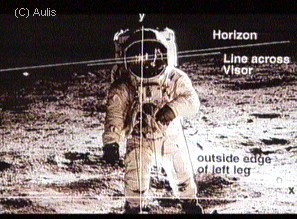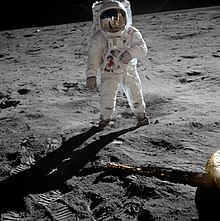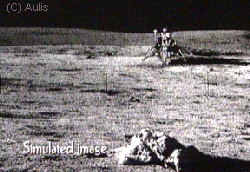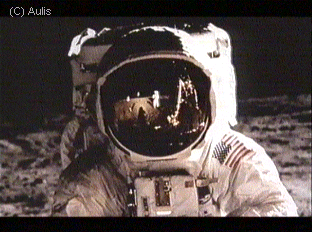Several nations have sent numerous spacecraft to the surface of the Moon. The Soviet Union performed the first moon landing in 1959 by destructively crashing the Luna 2 spacecraft at high speed onto the lunar surface, a feat duplicated in 1962 by the Americans with Ranger 4. During the time of the Cold War, such contests to be the first on the Moon with a particular capability was one of the most visible facets of the Space Race.
Only eighteen spacecraft have used braking rockets to survive their moon landings and perform scientific operations on the lunar surface – six manned, a dozen unmanned, all launched by either the Soviets or the Americans between 1966 and 1976. The USSR accomplished the first soft landings and took the first pictures from the lunar surface with ruggedized camera packages on their Luna 9 and Luna 13 missions. The Americans followed with five unmanned Surveyor soft landings and six manned Apollo missions. After the American manned Apollo landings, the Soviet Union later achieved sample returns of lunar soil via the unmanned Luna 16, Luna 20 and Luna 24 Moon landings; their Luna 17 and Luna 21 were successful unmanned rover missions. Not included in this accounting is the Soviet Luna 23 mission, which successfully landed but whose scientific equipment then failed, or the American Surveyor 4, with whom all radio contact was lost only moments before a possible perfect automated soft landing.
A total of twelve men have landed on the Moon. This was accomplished with two US pilot-astronauts flying a Lunar Module on each of six NASA missions across a 41-month time span starting on 21 July 1969 UTC, with Neil Armstrong and Buzz Aldrin on Apollo 11 (with Armstrong being first to set foot on the surface), and ending on 14 December 1972 UTC with Gene Cernan and Jack Schmitt on Apollo 17 (with Cernan being the last to step off the lunar surface). All Apollo lunar missions had a third crew member who remained onboard the Command Module. The last three missions had a rover for increased mobility.
The primary concerns of any moon landing are the high velocities involved that arise from the effects of gravity. In order to go to any moon, a spacecraft must first leave the gravity well of the Earth. The only practical way of accomplishing this currently is with a rocket. Unlike other airborne vehicles such as balloons or jets, a rocket is the only known form of propulsion which can continue to increase its speed at high altitudes in the vacuum outside the Earth's atmosphere.
Upon approach of the target moon, a spacecraft will be drawn ever closer to its surface at increasing speeds due to gravity. There are three possible outcomes: a crash landing where no attempt is made to slow down and the spacecraft is totally destroyed upon impact; a hard landing where the impact speed is reduced to less than 100 miles/hour or so, survivable by ruggedized machines but not humans; and a soft landing where the spacecraft decelerates precisely enough to land safely on the surface with negligible speed at contact. The first three attempts by the Americans to perform a successful hard moon landing with a ruggedized seismometer package in 1962 all failed. The Soviets first achieved the milestone of a hard lunar landing with a ruggedized camera in 1966, followed only months later by the first unmanned soft lunar landing by the Americans. The escape velocity of the target moon is roughly equivalent to the speed of a crash landing on its surface, and thus is the total velocity which must be shed from the target moon's gravitational attraction for a soft landing to occur. For Earth's Moon, this figure is 2.38 kilometres per second (1.48 mi/s). Such a change in velocity (referred to as a delta-v) is usually provided by a landing rocket, which must be carried into space by the original launch vehicle as part of the overall spacecraft. An exception is the soft moon landing on Titan carried out by the Huygens probe in 2005. As the only moon with an atmosphere, landings on Titan may be accomplished by using atmospheric entry techniques that are generally lighter in weight than a rocket with equivalent capability.
The Soviets succeeded in making the first crash landing on the Moon in 1959. Crash landings may occur because of malfunctions in a spacecraft, or they can be deliberately arranged for vehicles which do not have an on board landing rocket. There have been many such moon crashes, often with their flight path controlled to impact at precise locations on the lunar surface. For example, during the Apollo program the S-IVB third stage of the Saturn V moon rocket as well as the spent ascent stage of the lunar module were deliberately crashed on the Moon several times to provide impacts registering as a moonquake on seismometers that had been left on the lunar surface. Such crashes were instrumental in mapping the internal structure of the Moon.
If a return to Earth is desired after a moon landing is accomplished, the escape velocities of the Moon and Earth must again be overcome for the spacecraft to come to rest on the surface of the Earth. Rockets must be used to leave the Moon and return to space. Upon reaching Earth, atmospheric entry techniques are used to absorb the kinetic energy of a returning spacecraft and reduce its speed for safe landing. These functions greatly complicate a moon landing mission and lead to many additional operational considerations. Any moon departure rocket must first be carried to the Moon's surface by a moon landing rocket, increasing the latter's required size. The moon departure rocket, larger moon landing rocket and any Earth atmosphere entry equipment such as heat shields and parachutes must in turn be lifted by the original launch vehicle, greatly increasing its size by a significant and almost prohibitive degree. This necessitates optimizing the sizing of stages in the launch vehicle as well as consideration of using space rendezvous between multiple spacecraft. The intense and expensive effort devoted in the 1960s to achieving first an unmanned and then ultimately a manned moon landing can only be understood in the political context of its historical era. World War II with its 60 million dead, half Soviets, was fresh in the memory of all adults. In the 1940s, the war had introduced many new and deadly innovations including blitzkrieg-style surprise attacks used in the invasion of Poland and in the attack on Pearl Harbor; the V-2 rocket, a ballistic missile which killed thousands in attacks on London and Antwerp; and the atom bomb, which killed hundreds of thousands in the atomic bombings of Hiroshima and Nagasaki. In the 1950s, tensions mounted between the two ideologically opposed superpowers of the United States and the Soviet Union that had emerged as victors in the conflict, particularly after the development by both countries of the hydrogen bomb. On 4 October 1957, the Soviet Union launched Sputnik 1 as the first artificial satellite to orbit the Earth and so initiated the Space Age. This unexpected event was a source of pride to the Soviets and shock to the Americans, who could now potentially be surprise attacked by nuclear-tipped Soviet rockets in under 30 minutes. Also, the steady beeping of the radio beacon aboard Sputnik 1 as it passed overhead every 96 minutes was widely viewed on both sides as effective propaganda to Third World countries demonstrating the technological superiority of the Soviet political system compared to the American one. This perception was reinforced by a string of subsequent rapid-fire Soviet space achievements. In 1959, the R-7 rocket was used to launch the first escape from Earth's gravity into a solar orbit, the first crash impact onto the surface of the Moon and the first photography of the never-before-seen far side of the Moon. These were the Luna 1, Luna 2 and Luna 3 spacecraft.
Only eighteen spacecraft have used braking rockets to survive their moon landings and perform scientific operations on the lunar surface – six manned, a dozen unmanned, all launched by either the Soviets or the Americans between 1966 and 1976. The USSR accomplished the first soft landings and took the first pictures from the lunar surface with ruggedized camera packages on their Luna 9 and Luna 13 missions. The Americans followed with five unmanned Surveyor soft landings and six manned Apollo missions. After the American manned Apollo landings, the Soviet Union later achieved sample returns of lunar soil via the unmanned Luna 16, Luna 20 and Luna 24 Moon landings; their Luna 17 and Luna 21 were successful unmanned rover missions. Not included in this accounting is the Soviet Luna 23 mission, which successfully landed but whose scientific equipment then failed, or the American Surveyor 4, with whom all radio contact was lost only moments before a possible perfect automated soft landing.
A total of twelve men have landed on the Moon. This was accomplished with two US pilot-astronauts flying a Lunar Module on each of six NASA missions across a 41-month time span starting on 21 July 1969 UTC, with Neil Armstrong and Buzz Aldrin on Apollo 11 (with Armstrong being first to set foot on the surface), and ending on 14 December 1972 UTC with Gene Cernan and Jack Schmitt on Apollo 17 (with Cernan being the last to step off the lunar surface). All Apollo lunar missions had a third crew member who remained onboard the Command Module. The last three missions had a rover for increased mobility.
 Moon landing - Wikipedia |  The Moonlanding |  The Apollo Hoax |  The Moon Landing |  Lunar surface operations |
 The Apollo Hoax |  New moon landing given the |  Was the Moon Landing a Hoax? |  Apollo Moon Landings |  2 Moon landing |
The Soviets succeeded in making the first crash landing on the Moon in 1959. Crash landings may occur because of malfunctions in a spacecraft, or they can be deliberately arranged for vehicles which do not have an on board landing rocket. There have been many such moon crashes, often with their flight path controlled to impact at precise locations on the lunar surface. For example, during the Apollo program the S-IVB third stage of the Saturn V moon rocket as well as the spent ascent stage of the lunar module were deliberately crashed on the Moon several times to provide impacts registering as a moonquake on seismometers that had been left on the lunar surface. Such crashes were instrumental in mapping the internal structure of the Moon.
 Was The Apollo Moon Landing |  Aldrin poses for portrait |  The Moon Landing Hoax Evidence |  moon. |  Moon Image Gallery |
 The Apollo Hoax |  Moon Landing Conspiracy |  Moon Landing Memories |  The moon is our close cosmic |  Aldrin salutes the U.S. |
No comments:
Post a Comment